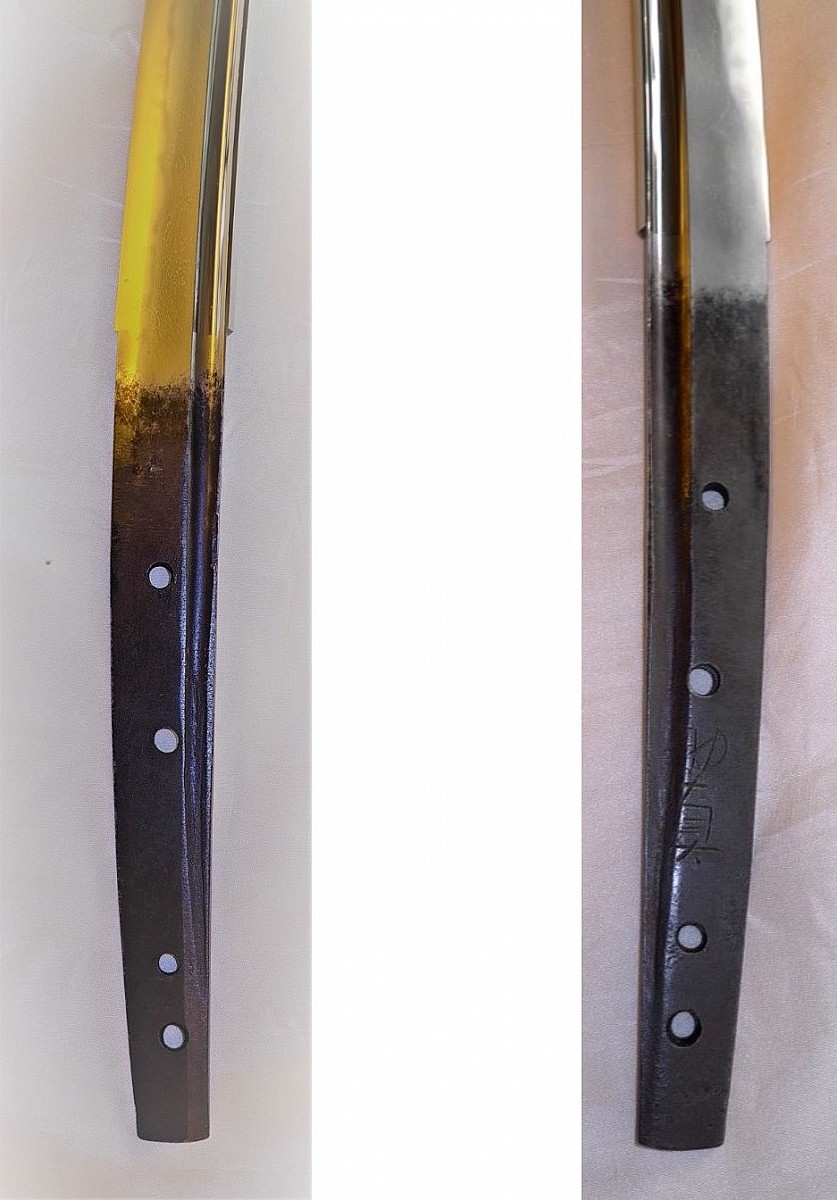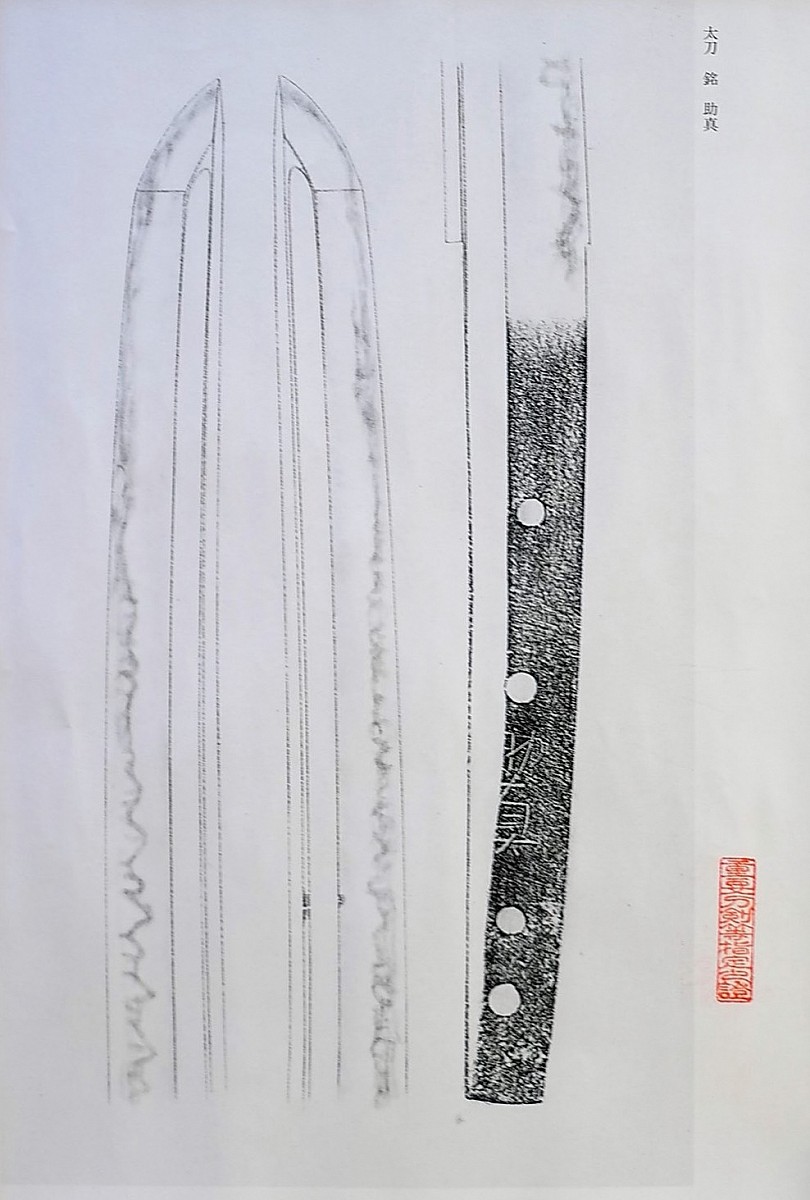Sukezane (助真), Kenchō (建長, 1249-1256), Bizen/Sagami – „Sukezane“ (助真), Fukuoka-Ichimonji school, according to transmission the son of Sukenari (助成), maybe also the son of Sukefusa (助房), first name „Tōgenji“ (藤源次), also „Gonnokami“ (権守), the transmission says that Sukezane was invited to Kamakura by shōgun prince Koreyasu (惟康親王). Kinai (畿内), saijō-saku.
Jūyō Tōken setsumei translation:
Designated as Jūyō Tōken on 35th jūyō tōken shinsa held in April 14, 1989
Tachi: tachi-mei SUKEZANE
Measurements: nagasa - 67.60 cm; sori - 2.10 cm; motohaba - 2.90 cm; sakihaba - 1.80; nakago nagasa - 19.90; nakago sori - 0.10 cm; kissaki nagasa - 1,75 cm.
Sugata: this tachi is forged in shinogi-zukuri, with iori-mune, normal mihaba rather deep koshi-zori and ko-kissaki.
Kitae: itame-hada mixed with mokume with impregnations of o-hada. There are ji-nie and midare-utsuri elements.
Hamon: choji-midare hamon combined with gunome, with ashi and yo; deep nioi, ko-nie and kinsuji.
Bōshi: shallow notare with ko-maru.
Horimono: bo-hi are engraved right through the both sides of the blade.
Nakago: suriage, shallow saki-kuri-jiri with katte-sagari yasurime on the omote side and kiri on the ura side. There are four mekugi-ana. The tachi-mei is consisted of two large-sized kanji chiselled on the haki-omote side starting from the middle downwards and centrally placed. The mei is partly intersects by the bo-hi on the left side of the nakago.
Swordsmith: Kamakura Ichimonji Sukezane.
Period: Middle of the Kamakura period.
Explanation: Sukezane, together with Yoshifusa and Norifusa, is one of the most representative swordsmiths of the Fukuoka Ichimonji School in the middle of the Kamakura period. According to a theory expressed in the Kanchi-in Bon Mei Zukushi (観智院本銘尽), known from the 30th year of the Ōei era (応永, the year 1423), Sukezane came to Kamakura located in Sōshū Province, so that he is also known as Kamakura Ichimonji, as well as Suketsuna is one of the member of the same group. Sukezane’s workmanship varies from nie-deki (both in the ji and ha) accompanied an inconspicuous utsuri, to nioi-deki hamon in the pure Bizen-Den style accompanied utsuri elements. His deki may display a mixture of these two traditions. His extant works also carry a wide range of different sizes of the signature’s kanji: from large-size to small-size. This tachi has the largest characters composing the signature among all Sukezane’s signatures and kanji’s style is rather different from the usual. However, the jiba and deki without any doubts falls within the range of his workmanship. The blade is a valuable study piece for research into changes in Sukezane’s style of signature.
* * * * * * * *
This sword was polished by Hon’ami Nisshū (本阿彌日洲, 1908–1996) in the 1980’s. He was awarded as Ningen Kokuhō (Living National Treasure) in 1975 along with a fellow polisher Ono Kōkei (小野光敬, 1913–1994). It was the first designation from the field of sword polishing. His given name was Takeo an he died in July, 1996. Hon’ami Nisshū was one of the best sword polishers of the second half of the twentieth century. He was the eldest son of Hirai Chiba (平井千葉, 1872 - 1937) and was adopted by Hon’ami Ringa (本阿弥琳雅, 1859-1927) as a representative of the seventeenth generation of the Kōi Hon’ami family.
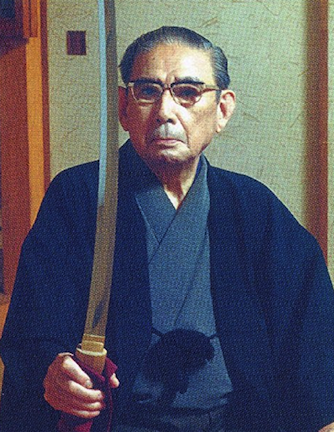
Figure 1. Hon’ami Nisshū.
This sword by Sukezane has seen battle, and shows some scars along the mune. It is so-called kirikomi (切り込み). Kirikomi were preserved by polisher and shown in the Jūyō oshigata as well. We know a lot of these swords were used to fight, but not many of them actually show the kirikomi to testify their service. So whenever we see these it’s good and lucky day.
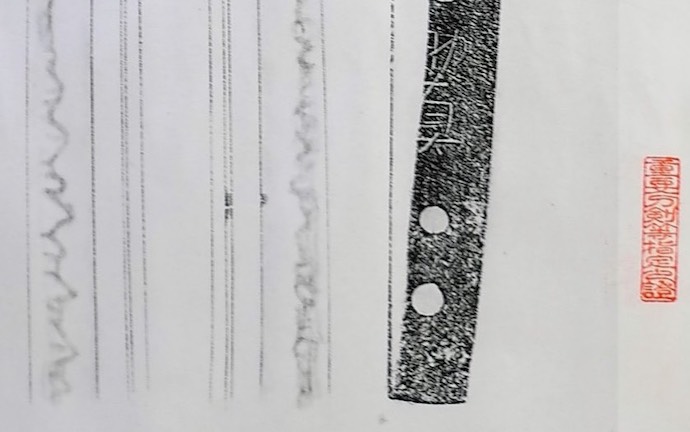
Figure 2. Kirikomi on the Sukezane's sword surface.
There is an interesting explanation for the «ichi» character in Ichimonji swords. Iwazaki Kōsuke san explains it using the term muteki (無敵), meaning «no enemy». The direct meaning of muteki - no enemy - is that no sword, and no warrior, could ever hope to stand against the one who would wield an Ichimonji sword. The Ichimonji School is composed of several branches, spanning different periods of time and residing in different areas of Bizen province. The name of Ichimonji is synonymous with the peak of the Bizen-Den's development, and their works in flamboyant chōji-midare with utsuri is unmissable and distinct in the history of the Japanese sword. Coming first were the Ko-Ichimonji (old Ichimonji) smiths in the late Heian and early Kamakura, followed by Fukuoka Ichimonji in the middle of the Kamakura period, then Yoshioka, Katayama and Iwato Ichimonji in the late Kamakura to end of the Nanbokuchō period. As well, we can indicate Kamakura Ichimonji, arisen in Sōshū at the order of the Hōjō regents.
Early Fukuoka Ichimonji works exhibit nie-deki which is inherited from its origins in Ko-Bizen. The style was developed during the period of the Gotoba Goban-Kaji (後鳥御番鍛冶) and spread its influence to swordsmiths as far away as Yamashiro province. Later would shift to nioi-deki which is heat hardened at a lower temperature, and is thought to be a development which allowed the Ichimonji swords to remain tough while taking on a large amount of hardened material as can be observed in their hamon which become increasingly flamboyant.
In the year 1208 the cloistered Emperor Gotoba (後鳥羽天皇, 1180–1239) drew up this list, a register that included the names of the thirteen smiths (one smith is for reserve) from three regions of Japan who replaced one another to cover each month of the year, while working to create an ideal sword. Three smiths from Yamashiro Awataguchi, three smiths from Bitchū Aoe, and seven smiths from Bizen Fukuoka: 1. Fukuoka-Ichimonji Norimune (福岡一文字則宗), 2. Fukuoka-Ichimonji Nobufusa (福岡一文字信房), 3. Fukuoka-Ichimonji Sukemune (福岡一文字助宗), 4. Fukuoka-Ichimonji Muneyoshi (福岡一文字宗吉), 5. Fukuoka-Ichimonji Yukimune (福岡一文字行宗), 6. Fukuoka-Ichimonji Sukenari (福岡一文字助成), 7. Fukuoka-Ichimonji Sukenobu (福岡一文字助延). Thus, the majority of Gotoba’s teachers coming from Fukuoka Ichimonji begins the long held belief of dominance of Bizen swords and the reverence of Fukuoka Ichimonji in the history of the Nihontō.
The two smiths Sukezane and Suketsuna together will sometimes be referred to as Fukuoka Ichimonji smiths from their origin, but are often referred to by the nickname «Kamakura Ichimonji». Though they never quite get to the Sōshū style on their own, we do see a wandering away from Bizen particularly in Suketsuna as he have been young at the time his father left Bizen and had more time to be influenced by the changes going on in Kamakura during his lifetime. What we do see through is that their nie are more intense than we would expect from Fukuoka Ichimonji smiths, which makes it easy to separate out their work from ordinary Fukuoka Ichimonji. The Suketsuna's signature do match with Sukezane's in the «suke» kanji being similar as whole.
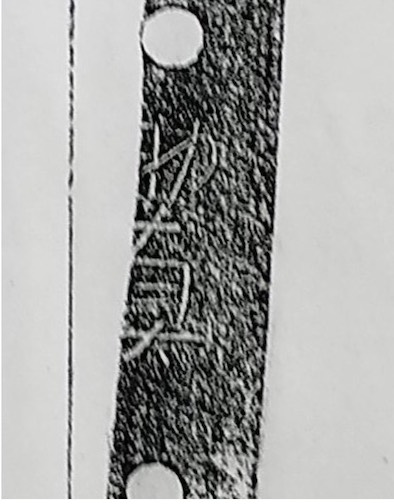
Figure 3. Kanji of the Sukezane's signature.
As of today (according to renewed statistics), 43 swords are known (Jūyō and above) to be Sukezane’s work. There are no “weak,” inexpressive works among them, which is proved by the large number of swords with the highest possible status. Of all his works known to us, 2 swords (tachi) have Kokuhō status; 9 swords (6 tachi and 3 katana) are Jūyō Bunkazai; 11 swords are Tokubetsu Jūyō Tōken; and 13 are Jūyō Tōken. Another 8 swords (3 tachi and 5 katana) were awarded Jūyō Bijutsuhin status in their time. Interestingly, as of now, none of those items have received NBTHK titles. Few of those works are signed: only 19 from all categories, plus 3 Jūyō Bijutsuhin swords.

Chikei
The NBTHK points out that one of the difference of Kamakura-Ichimonji sword is the presence of chikei (地景) which is literary can be translated as «shadow in the steel», i.e. black gleaming lines of nie in the ji area. This is formed from some combination of higher carbon content steel, and maybe impurities and special processes. Masamune was the master of chikei, closely followed by Norishige. This mastery of chikei and hataraki of nie is essentially what Masamune as famous as he is, the top smith in most books and the most famous of all time. His shapes in his swords were not particular elegant or powerful, they stood out though because he mastered the texture of the steel and brought out all possible activities. This feature is particularly associated with Sōshū-Den and one can find it in Gō Yoshihiro, Norishige and Yukimitsu works. So it’s clear that this time there is some combination of workmanship and material that brings it out. When we get to the Muromachi and Edo periods it seems that nobody can really do it anymore and certainly not to this extant. Whatever it was for
chikei, it starts with the material because we do see it in Sukezane and Suketsuna works and the chikei are quite obvious too, they form a network throughout the sword and in some areas are nearly as strong as those are in Masamune's works which were described in old manuscripts.
Utsuri
Kamakura Ichimonji Sukezane and Suketsuna continue to temper their swords using utsuri (映り) activity, a trait they carry over from their study in Fukuoka. Utsuri can be literary translated as «reflection», i.e. a misty visible reflection of the hamon appearing in the ji. It is said that this surface hardening used for compensation of the soft steel in ji area. This sword has clear and strong midare-utsuri. The true utsuri is quite a beautiful sight and to have an example that features it strongly is a real win. Utsuri is usually close to impossible to photograph but when it’s strong you can see the ghost image showing up on the frontal format shots. With the camera at an angle the the light, strong utsuri clearly pops out as a white and clear mist above the hamon.
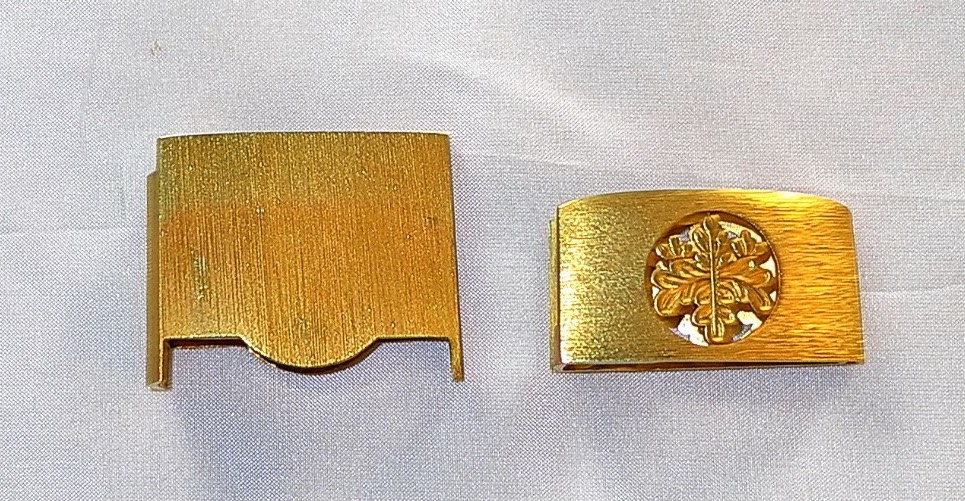
The solid gold habaki weighs 39.90 grams at over 22 ct of pure gold has the paulownia kiri mon. The use of the paulownia became very fashionable since the Kamakura period. Ranking second only to the chrysanthemum, the paulownia was exclusively associated with the Imperial Household by the time of Emperor Go-Daigo (後醍醐天皇), who conferred its use on Ashikaga Takauji. In time, Takauji ordered its use by his clan. Later, Oda Nobunaga and Toyotomi Hideyoshi conferred it on their generals for brave and faithful service. The paulownia graced the roofs of the great castles of Himeji, Osaka, Nagoya, and Fushimi which Hideyoshi built. After his death, the popularity of this mon declined but its use was perpetuated by the Daimyo and Hatamoto of the Toyotomi time.

